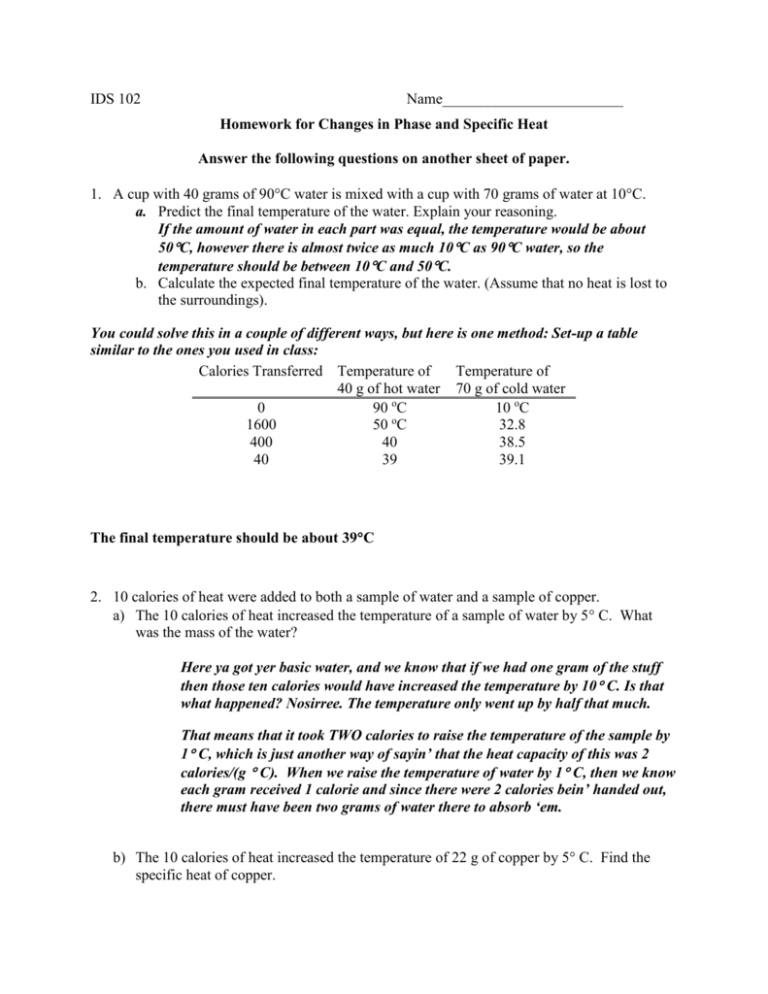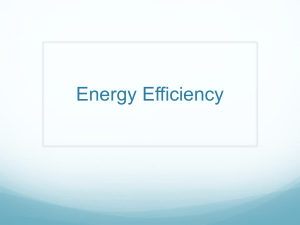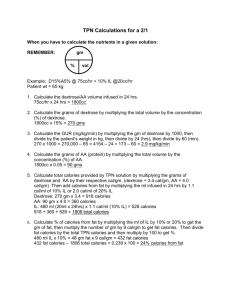Homework for Changes in Phase and Specific Heat
advertisement

IDS 102 Name________________________ Homework for Changes in Phase and Specific Heat Answer the following questions on another sheet of paper. 1. A cup with 40 grams of 90C water is mixed with a cup with 70 grams of water at 10C. a. Predict the final temperature of the water. Explain your reasoning. If the amount of water in each part was equal, the temperature would be about 50C, however there is almost twice as much 10C as 90C water, so the temperature should be between 10C and 50C. b. Calculate the expected final temperature of the water. (Assume that no heat is lost to the surroundings). You could solve this in a couple of different ways, but here is one method: Set-up a table similar to the ones you used in class: Calories Transferred Temperature of Temperature of 40 g of hot water 70 g of cold water 0 90 oC 10 oC o 1600 50 C 32.8 400 40 38.5 40 39 39.1 The final temperature should be about 39C 2. 10 calories of heat were added to both a sample of water and a sample of copper. a) The 10 calories of heat increased the temperature of a sample of water by 5 C. What was the mass of the water? Here ya got yer basic water, and we know that if we had one gram of the stuff then those ten calories would have increased the temperature by 10 C. Is that what happened? Nosirree. The temperature only went up by half that much. That means that it took TWO calories to raise the temperature of the sample by 1 C, which is just another way of sayin’ that the heat capacity of this was 2 calories/(g C). When we raise the temperature of water by 1 C, then we know each gram received 1 calorie and since there were 2 calories bein’ handed out, there must have been two grams of water there to absorb ‘em. b) The 10 calories of heat increased the temperature of 22 g of copper by 5 C. Find the specific heat of copper. Here ya got yer basic copper and I don’t know the heat capacity of copper off the top of my head which is why I’m mighty glad that they told me the mass of the copper and asked me to figure out the heat capacity. If they hadn’t told me the mass or the heat capacity I would have been hornswaggled. Okay, if it took 10 calories to raise the temperature by 5 C then it stands to reason that we would have only needed 2 calories to raise the temperature by 1 C. This piece of copper has the same heat capacity as the water in the last problem! Now we need to know how much it would have taken to raise the temperature of 1 gram by 1 C. Since 2 calories were enough to raise the temp of 22 grams by that much we only needed (2/22) or about 0.09 calories for each gram to increase in temperature by 1 C. That’s just another way of sayin’ that the specific heat of copper is about 0.09 cal/(g C). (NOTICE: This is about the same heat capacity that we found for iron which makes sense since as long as you can’t see the color it isn’t easy to tell iron from copper without a magnet and we don’t suppose the calories care about the color or the magnetism.) 3. In a lab experiment, an 80 g sample of water at 20 oC is mixed with 80 g of aluminum at 50 o C. The specific heat of aluminum is 0.20 cal/goC. In other words, it takes only 0.2 calories to raise the temperature of 1 g of aluminum by 1 oC. a. What is your estimation of what the final temperature of the mixture will be? (Do not do any calculations yet). Explain your reasoning. Well, the specific heat of aluminum is only about one-fifth of the specific heat of water. That means that 80 g of aluminum has the same heat capacity as 16 g of water. In this case we expect the final temperature to be a lot closer to the initial temperature of the 80 g of water, so I’m guessing it will be around 25 C, or maybe 30 C. b. How many calories are required to change the temperature of 1 gram of aluminum by 5oC? Show your work. Just one calorie… (not Calorie) Each gram requires only 0.2 calories to increase in temperature by 1 C, so 1 g will require five times as much heat, or 1.0 calories to increase in temperature by 5 C. c. How many calories are required to change the temperature of 80 grams of aluminum by 5 o C? Show your work. For 80 grams of aluminum we will need 80 times as much heat, or 80 calories. d. Complete the following table by filling in the number of calories needed to change the temperature of the aluminum by 5 oC, and the resulting temperature change of the cold water. Continue until you have determined the final temperature of the mixture. (Note: if you have trouble doing this in 5 oC increments, you can do it in 1 oC increments, but it will take many more steps) Total Calories Transferred 0 80 160 240 320 400 Temperature of 80 Temperature of g of aluminum 80 g of cold water o 50 C 20 oC o 45 C 21 C 40 C 22 C 35 C 23 C 30 C 24 C 25 C 25 C e. What is the final temperature of the mixture? 25 C f. How many total calories are transferred? 400 calories. g. What is the temperature change of the water in this experiment? 5 C h. What is the temperature change of the metal in this experiment? 25 C i. Compare the heat lost by the metal to the heat gained by the water. Explain your reasoning. The heat lost by the piping hot metal is EXACTLY THE SAME as the heat gained by the oh-so-cool water. All of the heat lost by the metal goes into the water. Honest. 4. Use the following information to answer the question below. Specific Heat of Water: 1 cal/goC Heat of vaporization of water: 540 cal/gram a) Imagine 50 g of steam at 100oC. Calculate the amount of heat released when this steam first condenses to liquid water, then cools to 40oC. Show your work. First the steam must change phase to water: 50g X 540 cal/g = 27,000 calories Next, the water must cool from 100C to 40C: 50g X 60C X 1 cal/gC= 3000 cal The total heat lost would be 27,000 cal + 3000 cal= 30,000 cal b) Perhaps you are aware that steam burns are considerably more painful than burns from boiling water. If the steam is at 100oC, why would a burn from steam be worse than a burn from boiling water? Steam at 100C must lose 540 calories for each gram of water to condense to water at 100 C. This heat is transferred to the object where the steam is condensing, such as a person’s skin. 4. . 5. The temperature in the freezer compartment of a typical household refrigerator is about – 15oC. Thus, an ice cube taken from the freezer must first warm up to 0oC before it will begin to melt. The specific heat of ice is 0.51 cal/g-oC and its latent heat of fusion is 80 cal/g. Imagine that a 10 g cube of ice at –15oC is taken from the freezer and added to 100 g of water in a Styrofoam cup. The temperature of the 100 g of water is initially 22oC. What is the final temperature of the water after all the ice has melted? Show all your work. a. Begin by determining the amount of energy required to heat the ice cube from –15oC to 0oC. Assume that none of the ice melts. The heat to warm the ice to 0C is: Heat = 10 grams X 15 C X 0.51 cal/gC = 76.5 cal b. Next, find the amount of energy required to melt the ice cube. Show your work. 10 grams X 80 cal/g= 800 cal c. The sum of your answers to parts a and b represents the total amount of heat required to warm the ice cube up to 0oC and melt it. Since the ice cube was added to a cup of water, this energy will come from the water, causing its temperature to decrease. Calculate the temperature of the cup of water after the ice cube has melted. 876.5 cal = 100 grams of water X T X 1 cal/gC T= 8.8C The water started at 22C, so the final temperature would be 22C-8.8C= 13.2C d. Your answer to part c is not the final temperature of the mixture, because after the ice cube has melted it is still at 0oC. Thus the cup now contains 10 g of water at 0oC and 100 g of water at the temperature found in part c. These two samples of water will exchange heat until they reach an equilibrium condition. Set up a table like the one we used last quarter to work out the final temperature. To make the calculations easier, determine the amount of heat necessary to lower the temperature of the 100g of water by 0.2oC. Then determine the temperature of the 10 g of cold water when it receives this heat. Continue until you have determined the equilibrium temperature.\ (see table on next page) (table for problem 5) Calories transferred (cal) 0 20 20 20 20 20 20 Temperature of the 100 g water (C) 13.2 13.0 12.8 12.6 12.4 12.2 12.0 Temperature of the 10 g water (C) 0 2 4 6 8 10 12 6. Grandpa always put a large tub of water in his root cellar (a place where he stored his crops during the winter. Normally it is below ground or covered by soil) when winter neared. He explained that it helped protect the fruit and vegetables during a short cold spell. Explain why Grandpa put a tub of water in his root cellar. There are two concepts on this one. First the water has a high specific heat, so the water serves as a heat reservoir in the root cellar. And second, the water would release 80 cal/g as the water transformed from a liquid to a solid. The root cellar would receive this heat from the tub of water and this would help protect the crops when the temperature was near freezing. 7. The heat of vaporization of water is 540 cal/gram. When water vapor in the atmosphere condenses to form liquid water (rain), this amount of heat is released. This release of heat causes the temperature of the air to rise slightly. Imagine a sample of air with a volume of 1 m3. The density of air is 1.0 kg/m3, and the specific heat of air is approximately 0.23 cal/goC. When 1 gram of water vapor condenses, by how much will the temperature of the sample of air change? Show your work. If one gram of water condenses then 540 calories of heat will be released. We need to know the amount of mass in the 1 cubic meter of air. To get that we change the density formula into M=V * D; so, the mass of the air would be: Mass = 1 cubic meter times 1 kg/ cubic meter= 1 kg= 1000 g So, the 540 calories are heating 1000 grams of air. Heat = mass X change in temperature X specific heat 540 calories = 1000 g X change in temperature X 0.23 cal/g degrees C The change in temperature would be 2.3 degrees C 8. Many people expect that a lava flow will melt almost anything in its path, but this does not seem to be the case. Explain why lava flows do not melt the rock they flow over. (You need to say more than lava flows are not hot enough!) (Some data you will need: Assume the lava is about 1100 degree C and it solidifies at 1000 degrees C. The average temperature of the ground in this location is 25 degrees C and that the lava is flowing over old lava flows of the same composition). Several things to consider on this one— 1) The mass of the lava flow is much smaller that the mass of the other rock around it. 2) The lava must heat the surrounding rock to 1000C before it can melt and in the process the lava will drop more than 100C and become solid itself. 3) Just like melting ice, melting rock requires more heat (volcanic rock’s heat of fusion) just to melt the rock even if the temperature is at the melting point.






